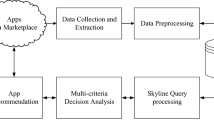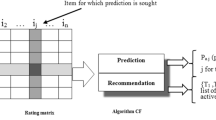Abstract
Many social marketing systems use decision-making strategies for implementing product dominance analysis. The objective of the proposed work is to classify on-time issues in observing highly preferable market products, which is newer in online market places. Existing researches are interested to be useful for customers to identify the best possible products groups from the vast product details. To deal with this main objective, different types of product instances are reviewed. In this case, the price of popular products and the product groups are evaluated. This proposed system analyses the need for online market growth using novel skyline query analysis. The proposed system monitor user-based ratings affect the sales of various products. After finding the desirable products, the market prices are predicted. Once products are predicted, the new packages are assigned with optimal prices and added to the package database. Moreover, the proposed Skyline Query Optimization and Security Management System (SQOSMS) approach is focused on authorized user ratings and ensures they are more secured. The review system validates each and every user identities with the user activities involved with in review system. This is considered as major objective of this proposed system. The implementation section shows that the proposed system provides 10–15% of reduced movie lists than other systems. This illustrates the proposed SQOSMS’s controlled performance over the selection of preferable products.








Similar content being viewed by others
Change history
12 December 2022
This article has been retracted. Please see the Retraction Notice for more detail: https://doi.org/10.1007/s11277-022-10121-5
References
Peng, Y., Wong, R. C., & Wan, Q. (2012). Finding Top-k preferable products. IEEE Transaction on Knowledge and Data Engineering, 24(10), 1774–1788.
Liu, Y., Huang, X., An, A., & Yu, X. (2008). Modeling and predicting the helpfulness of online reviews. In Eighth IEEE international conference on data mining.
Chomicki, J, Godfrey, P., Gryz, J., & Liang, D. (2009). Skyline with pre-sorting. In Proceedings of international conference on data engineering (ICDE) (pp. 717–816).
Chaudhry, S., et al. (2020). Correcting design flaws: An improved and cloud assisted key agreement scheme in cyber physical systems. Elsevier Computer Communications Journal, 153(1), 527–537.
Hu, S., et al. (2020). Reviewer credibility and sentiment analysis based user profile modelling for online product recommendation. IEEE Access, 8(1), 26172–26189.
Chaudhuri, S., Dalvi, N. N. & Kaushik, R. (2006). Robust cardinality and cost estimation for skyline operator. In Proceedings international conference on data engineering (ICDE) (p. 64).
Sokolova, K., & Kefi, H. (2020). Instagram and YouTube bloggers promote it, why should I buy? How credibility and parasocial interaction influence purchase intentions. Journal of Retailing and Consumer Services, 53.
Acquisti, A., & Fong, C. (2020). An experiment in hiring discrimination via online social networks. Management Science, 66(3), 1005–1024.
Liu, Y., Liu, A., Liu, X., & Huang, X. (2019). A statistical approach to participant selection in location-based social networks for offline event marketing. Information Sciences, 480, 90–108.
Crankshaw, D., Bailis, P., Gonzalez, J. E., Li, H., Zhang, Z., Franklin, M.J., Ghodsi, A., & Jordan, M. I. (20114). The missing piece in complex analytics: low latency, scalable model management and serving with velox. In IEEE conference.
Baldacchino, C. (2016). Automatic prediction of stock price direction based on multivariate time series and machine learning. University of Malta, thesis.
Wu, C.-Y., & Ahmed, A. (2017). Predicting latent structured intents from shopping queries. In International World Wide Web conference committee (IW3C2), ACM, WWW 2017.
Yang, Y., Lichtenwalter, R. N., & Chawla, N. V. (2014). Evaluating link prediction methods. Knowledge and Information Systems, 45(3), 751–782.
Shah, D., Isah, H., & Zulkernine, F. (2019). Stock market analysis: a review and taxonomy of prediction techniques. Journal of Financial Studies, 7(2), 26.
Preethi, P., & Pradeep, R. (2015). Price prediction system using data anonymity and Top-k products. International Journal of Latest Trends in Engineering and Technology (IJLTET), 5(1).
Lundkvist, E. (2014). Decision tree classification and forecasting of pricing time series data. Master’s Degree Project, Stockholm, Sweden.
Heston, S. L., & Sinha, N. R. (2016). Finance and economics discussion series divisions of research and statistics and monetary affairs, news versus sentiment: predicting stock returns from news stories. Federal Reserve Board, Washington, D.C.
Akram, W., Babu, M., Roy, O., & Reddy, L. N. (2018). A comprehensive way of finding Top-K competitors using C-Miner algorithm. International Research Journal of Engineering and Technology (IRJET), 5(3).
Veeramalai, S., Praveen, T., & Pradeepa Natarajan, S. (2018). Cost based on product quality prediction using data mining. International Journal of Trend in Scientific Research and Development (IJTSRD). https://doi.org/10.31142/ijtsrd14564.
Carta, S., Medda, A., Pili, A., Reforgiato Recupero, D., & Saia, R. (2018). Forecasting E-commerce products prices by combining an autoregressive integrated moving average (ARIMA) model and google trends data. Future Internet, 11, 5.
Kalpana, G., Prasanna Kumar, R., & Ravi, T. (2010). Classifier based duplicate record elimination for query results from web databases. In IEEE international conference on trendz in information sciences and computing (TISC) (pp. 50–55).
Al-Turjman, F. (2019). Cognitive routing protocol for disaster-inspired internet of things. Elsevier Future Generation Computer Systems, 92, 1103–1115.
Ghose, A., & Ipeirotis, P. G. (2011). Estimating the helpfulness and economic impact of product reviews: mining text and reviewer characteristics. IEEE Transaction on Knowledge and Data Engineering, 23(10), 1498–1512.
Danescu-Niculescu-Mizil, C., Kossinets, G., Kleinberg, J., & Lee, L. (2009). How opinions are received by online communities: a case study on amazon.com helpfulness votes. In Proceedings of the 18th international conference on World Wide Web (WWW ’09) (pp. 141–150).
Chen, L., Cui, B., & Lu, H. (2011). Constrained skyline query processing against distributed data sites. IEEE Transactions on Knowledge and Data Engineering, 23(2), 204–217.
Shen, W. (2008). Essays on online reviews: The relationships between reviewers, reviews, and product sales, and the temporal patterns of online reviews. Ph.D., Krannert Graduate School of Management, Purdue University.
Wang, S., Ooi, B. C., Tung, A. K. H., & Xu, L. (2007). Efficient skyline query processing on peer-to-peer networks. In Proceedings of international conference on data engineering (ICDE) (pp. 1126–1135).
Papadias, D., Tao, Y., Fu, G., & Seeger, B. (2003). An optimal and progressive algorithm for skyline queries. In Proceedings of the 2003 ACM SIGMOD international conference on management of data (pp. 467–478).
Chevalier, J. A., & Mayzlin, D. (2006). The effect of word of mouth on sales: Online book reviews. Journal of Marketing Research, 43(3), 345–354.
Borzsony, S., Kossmann, D., & Stocker, K. (2001). The skyline operator. In International conference on data engineering (ICDE) (pp. 421–430).
Archak, N., Ghose, A., & Ipeirotis, P. G. (2007). Show me the money! Deriving the pricing power of product features by mining consumer reviews. In Proceedings of the 13th ACM SIGKDD international conference on knowledge discovery and data mining (KDD ’07) (pp. 56–65).
Gupta, R., et al. (2020). Smart contract privacy protection using AI in cyber-physical systems: tools, techniques, and challenges. IEEE Access, 8(1), 24746–24772.
Author information
Authors and Affiliations
Corresponding author
Additional information
Publisher's Note
Springer Nature remains neutral with regard to jurisdictional claims in published maps and institutional affiliations.
This article has been retracted. Please see the retraction notice for more detail: https://doi.org/10.1007/s11277-022-10121-5
Rights and permissions
Springer Nature or its licensor (e.g. a society or other partner) holds exclusive rights to this article under a publishing agreement with the author(s) or other rightsholder(s); author self-archiving of the accepted manuscript version of this article is solely governed by the terms of such publishing agreement and applicable law.
About this article
Cite this article
Soundararajan, R., Kumar, S.R., Gayathri, N. et al. RETRACTED ARTICLE: Skyline Query Optimization for Preferable Product Selection and Recommendation System. Wireless Pers Commun 117, 3091–3108 (2021). https://doi.org/10.1007/s11277-020-07592-9
Published:
Issue Date:
DOI: https://doi.org/10.1007/s11277-020-07592-9




